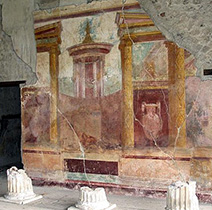 1
1Type II - "tholos shrine"
Little identified 'type II tragic style wall-paintings' as walled-up central entrances above which can be seen a 'tholos shrine'. This is exemplified by the wall-paintings on the lateral walls of the Casa del Labirinto oecus Corinthius (Fig.1); cubiculum M in Villa P. Fannius Synsitor, Boscoreale (fig.2); and a fragment from the Villa di Diomede (fig.3).
Once again there is a fundamental problem in claiming the above as alternative depictions of tragic stage sets because none of them depict entrances to royal palaces or objects that are uniquely associated with royalty or even high status. The tholos, the central image in all of these paintings, is an image associated with religious or ancestral commemoration. Its location within a walled or colonnaded space is designed to emphasise this. An axonometric projection of the space surrounding the Labirinto tholos clearly shows this to be the case. The presence of broken pediments above the tholos in both the Labirinto and Synistor paintings confirms that we are looking at commemorative architecture, either dedicated to divinities or ancestors or both. The truncated pediments on many of the Petra rock cut tombs confirms this to be the case. This reading is further reinforced by the depiction of culinary offerings in all three paintings, incense burners in both Synistor paintings, and an altar table in the Labirinto painting.
The act of worship is unambiguously depicted in the Casa di Diomede painting in which a woman can be seen placing a pear at the base of the tholos (fig.4). It's also worth pointing out that this painting did not encompass a whole wall but was probably presented as a vignette within a larger composition, such as those found in the Casa dei Vettii.
As pointed out previously, the eagle and the crown depicted in the Labirinto tholos does not necessarily indicate royalty or even an imperial presence because the painting is generally though to precede Imperial rule. The eagle as a symbol of apotheosis also fits perfectly with the concept of the tholos as an honorific shrine. The presence of the heroic dead, symbolised by shields placed between each column supports this assumption, as does the presence of Dionysus, symbolised by the ivy that wraps itself around the columns. Hence, in conclusion, we are not looking at a depiction of a royal palace but a composition intended to have a cathartic function, in that it allows the living to ‘reconstruct’ the dead through the act of re-membering. The tholos invites you to find solace through divine worship and ancestral commemoration. Therefore whilst it's funerary association may have tragic overtones, it real function is to symbolise hope through eternal renewal.
 1
1
|